I played White in the following game, in the fall of 2015, at a chess club in the Salt Lake Valley of Utah. As usual with me, I recorded the game on paper, although it was informal and without chess clocks.
1) Nf3 d5
Strange to tell, but I was unprepared for this obvious and simple response to Nf3. I would have done better to have begun with c4, for I was better prepared for playing the English Opening. My greatest weakness, at present, may relate to knowledge of openings.
2) d4 . . . . I did not see anything better. I had no desire for my opponent to play d4
2) . . . . Bg4
Here I remembered that some club players give up their bishops for their opponents’ knights. Since I would be delighted to have the advantage of the bishop-pair, I gave my opponent that opportunity.
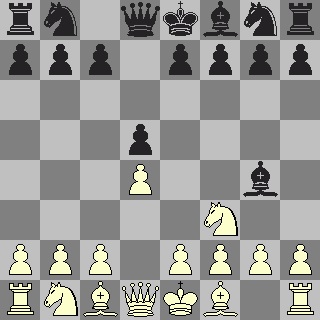
Diagram-1 after Black’s Bg4
3) Bf4 Bxf3
4) exf3 . . . .
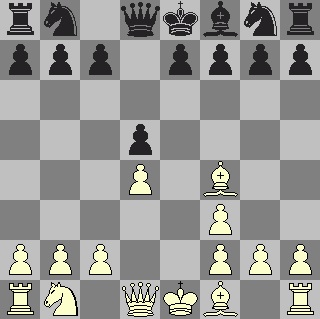
Diagram-2 after White recaptured
What did I gain from that exchange? I had the bishop-pair and a slight lead in development, for my light-squared bishop is ready for development. I also had a half-open e-file. My opponent, on the other hand, got rid of what could have become a bad bishop, and he gave me doubled pawns. He also gained a slight edge in center-pawn power, for I was almost compelled to capture away from the center, with my e-pawn, to avoid making my kingside too weak for castling there.
4) . . . . e6
5) c4!? . . . .
Looking back at this game, a few days later, I’m not sure of this move (c4).
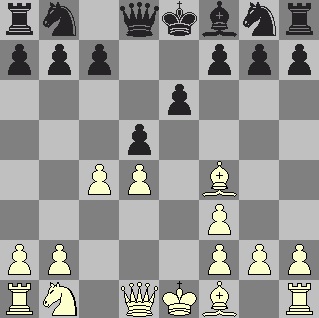
Diagram-3 after White’s c4!?
I might have done better with 5) c3 instead. The problem with that approach, which I recognized at the time, was that my opponent would then be able to play c5, with the threat of advancing his pawn further with c4, gaining more space on the queenside. After Black’s advance c5, if I then would capture with dxc5 I would have no center pawns and my opponent would have two.
5) . . . . dxc4
6) Bxc4 Nc6
7) Bb5 . . . .
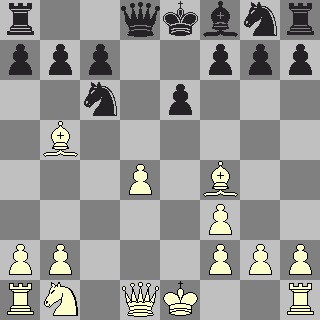
Diagram-4 after White’s Bb5
7) . . . . Qd5
8) Qa4 O-O-O
9) Bxc6 Qxc6
10) Qxc6 bxc6
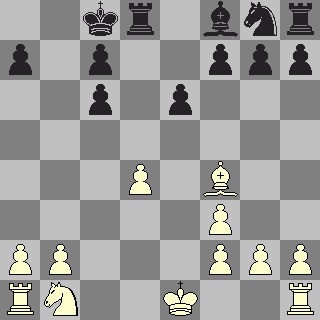
Diagram-5 after the exchange of queens (White’s move)
I felt that my chances were better, although I had a weak isolated pawn, for my opponent had three of those, two of them being doubled. But in the position shown in Diagram-5 I did not want to be tied down in defense, so I gave up defending my isolated pawn.
11) O-O . . . . I wanted to get my king out of any potential difficulties
11) . . . . Rxd4
I was not much worried about losing a pawn here because my opponent’s resulting pawn majority, on the queenside, is badly crippled
12) Be3 Ra4 Black must hold onto his a-pawn
13) Nc3 Ra5
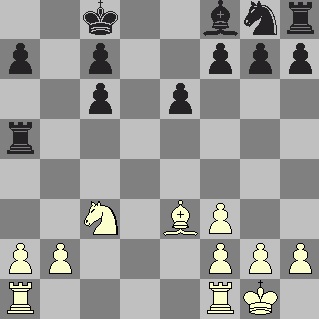
Diagram-6 after Black’s 13th move: Ra5
At this time, I wanted to trap that rook, a questionable goal. If it’s forced to a6 (after I safely get my b-pawn to b4), how can I attack it there? On looking back at this position, I now think I should have been satisfied at keeping that black rook on the a-file and developing my own rooks.
14) a3 . . . .
Now my a-file rook is free to move to c1, although I had another idea at the time. By moving my queenside pawns to a3 and b4, and getting my knight to c5, that black rook would have been almost imprisoned. But there was a problem.
In the position shown in Diagram-6, it can take as few as two moves for Black to get his knight to d5, a great outpost from which it cannot be driven away by any of my pawns and on which it cannot be captured by my dark-squared bishop. If I exchange knights on d5, my opponent will get a protected passed pawn and undouble his rooks. I did not, however, foresee those possibilities at this point in the game.
14) . . . . Rh5
My opponent appeared to fear having his rook trapped on the queenside, but that piece is even more vulnerable on the kingside.
15) g4 . . . . better might have been Rac1, for the g4-pawn later becomes a target
15) . . . . Ra5
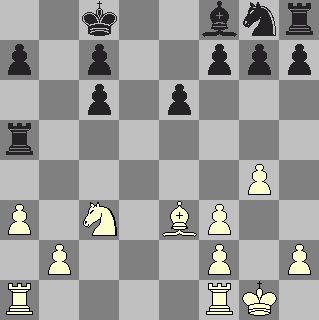
Diagram-7 after Black’s 15th move: Ra5
16) b4!? . . . .
After the game, I thought that Rac1 would have been better, for I can double rooks on the c-file and use my knight and bishop against Black’s weak pawns and squares on that file.
16) . . . . Ra6
The black rook will sit on that square for about thirteen moves, but what about my rook on a1? My rook is also tied down to protecting my a-pawn.
17) Ne4 Be7
That looked like a strange move to me. I would have put my knight there, if I were Black.
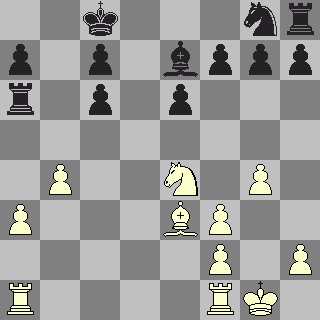
Diagram-8 after Black’s Be7
18) Nc5 Bxc5 I was hoping for that exchange, to get a bishop versus a knight
19) Bxc5 Nf6 too bad for me, for Black’s knight gets a great outpost
20) Bd4 . . . .
Now that I’ve gotten a bishop against a knight, I changed my mind: I want to trade it away to prevent my opponent from having his knight at d5.
20) . . . . Nd5
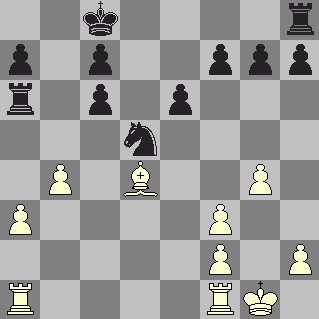
Diagram-9 after Black’s Nd5
In Diagram-9, it looks like White might put the black rook in prison by moves like Bc5, a4, and a5. But Black has aggressive plans of his own, related to the pawn I now capture.
21) Bxg7 . . . . I could not resist getting this pawn
21) . . . . Rg8
22) Bd4 h5!? this did not quite work for my opponent, as the game progressed
23) h3 hxg4?
This gives me a protected passed pawn on a rook file: not usually desirable to give your opponent in the endgame.
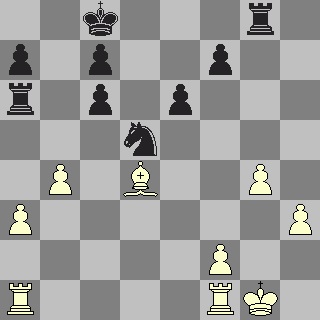
Diagram-10 White soon obtained a winning advanced passed pawn
The games lasted for an additional 23 moves. My opponent was forced to give up his rook for my advanced pawn on the h-file. A few moves later, I sacrificed my rook for my opponent’s advanced center-passed-pawn. My king, however, ended up in a much better position, allowing me to be able to capture Black’s last remaining pawn and to promote my last remaining pawn to a queen. My opponent made me work for the win.
###
.
The Backyard Professor of Chess
If only more people had as much enthusiasm for intellectual pursuits! Kerry Shirts, known as the “Backyard Professor” of chess (on Youtube) dives into the royal game, including analysis of some of his own games.
The Chess Coach Jonathan Whitcomb
I played first board, for our school chess club, in junior high school team matches in Pasadena, California. I later won the first Pasadena Chess Club Junior Championship in 1966 . . .
What is the chess-playing skill of the gift recipient, when you’re to give a chess book as a gift? That’s a big question needing an answer.
Four books that appear to be for the beginner
.



Pingback: End Game Logic | Chess Logic